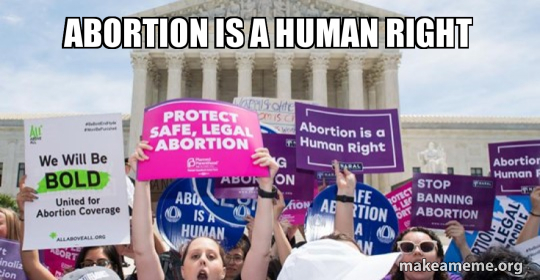Study: SCOTUS created two-tier health care system with Dobbs decision
Interviews with providers in abortion restrictive, protective states show ruling has negatively affected health delivery; argues court ignored question of gender
LAWRENCE — When the Supreme Court overturned the constitutional right to abortion, it did so by insulating itself from considering the effect the decision would have on women and marginalized communities, according to authors of a new study.
By refusing to connect the decision in Dobbs v. Jackson Women’s Health Organization to the gendered impact of its decision, the authors said the decision has resulted in a two-tiered system of health care that exacerbates existing disparities.
Alesha Doan, professor of public affairs & administration and women, gender & sexuality studies, is co-author of a study that examines the Dobbs decision, published in the Journal of Women, Politics & Policy.
In a critical legal analysis of the Dobbs decision, the authors wrote that the court did not connect abortion with “invidiously discriminatory animus against women” by claiming the topic was not about gender, nor did preventing abortion constitute sex discrimination. That ignores previous abortion cases like Roe v. Wade and Planned Parenthood v. Casey, both of which noted clearly that gender was paramount in the issue.
“The majority opinion in Dobbs completely dismissed and ignored the fundamentally gendered reality of abortion,” Doan said. “There is a line in the majority opinion that says, ‘This has nothing to do with gender.’ However, if you read the briefs submitted by hundreds of experts, providers, physicians, advocates and others, it is expressly present. And it is present in decades of research that provides empirical evidence that women suffer medical, legal, economic and other dire consequences when the government criminalizes abortion.”
The Supreme Court's dissenting opinion also pointed out that gender was a central component of previous rulings on the matter, in addition to amicus briefs submitted to the court, Doan said. The result in curtailing women’s rights is unique in that legal arguments are generally on the side of expanding rights, she added, but the court insulated itself from discussion of removing rights by claiming the case was not about gender.
The study, co-written with Lori Brown of Syracuse University and Shoshanna Ehrlich of the University of Boston, connects a critical legal analysis with an examination of how the Dobbs decision has affected practitioners and those seeking abortion care. The authors conducted interviews with 22 providers in states with both abortion restrictions and protections.
Providers were interviewed after the Dobbs case was argued but before the decision was announced. That uncertain period, including the leaking of the decision to the media, created a snapshot of a fraught period of time. Results showed that providers were highly concerned about how the decision would affect their ability to deliver care equitably.
About a year after the Dobbs decision, approximately half of the providers were interviewed again. Many worked in states where abortion was criminalized or in the process of being criminalized.
“If you take one thing away from this paper, it should be the compounding inequality that resulted after Dobbs," Doan said. "Although these were issues that existed before the decision, they have dramatically increased the difficulty for society’s more vulnerable people to receive abortion care, reproductive health care, reduce the quality of care they do receive and so much more.
“We know that women of color and people living in poverty have poorer health outcomes, and the physicians we interviewed unanimously expressed their concern about how this disparity will only get worse,” she said.
Providers expanded on how the decision has reduced the quality of care they could provide. Specifically, for women who travel to abortion-protective states, they often do not have the time for follow-up visits or to spend more than the minimum time at a care facility because of child care or work responsibilities waiting at home, or they cannot afford the travel-related costs of a longer stay.
Further, routine OBGYN care dictates that doctors serving a pregnant woman ask questions such as how many times they have been pregnant and how many miscarriages or abortions they have had previously.
“Because abortion is criminalized in many states, miscarriages may be called into question, so people are less willing to disclose them to their physician if they are criminal,” Doan said. “That’s just one of many ways the quality of reproductive health care has been compromised and reduced.”
Providers also expressed concern about the training of future doctors and health care providers. Several noted that medical schools in their states can no longer provide training on how to manage miscarriages, a common occurrence and necessity for OBGYN practitioners, or how to perform abortions. Medically, they are the same, but because the latter is now illegal in some states, some schools are shying away from its teaching.
Additionally, OBGYN residents are accepting more residencies in abortion-protective states, interviewees said. And data shows that residents tend to continue their medical careers in the states in which they complete residences, Doan added.
As a result, some states will have fewer fully trained health care providers, not only in OBGYN, but family medicine and other areas, the interviewees said.
As the dissenting justices wrote, the Supreme Court’s majority decision and claim the Dobbs decision was not about gender shows it “knows or cares little about women’s lives or about the suffering its decision will cause,” which the authors underscore in the study.
“You’re getting a two-tiered system of medical training, which translates to a two-tiered system of health care delivery. This was a very significant concern voiced in the interviews, this fracturing of reproductive medical care and what it will mean for deepening the existing inequitable health outcomes for women of color and other communities living in precarity,” Doan said.
JOURNAL
Journal of Women Politics & Policy
METHOD OF RESEARCH
Observational study
SUBJECT OF RESEARCH
People
ARTICLE TITLE
Dobbs, Gender Animus, and the Impact on Abortion Providers

No comments:
Post a Comment